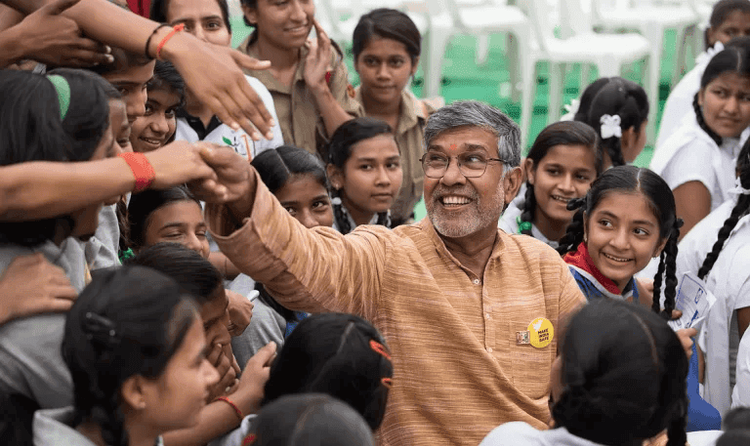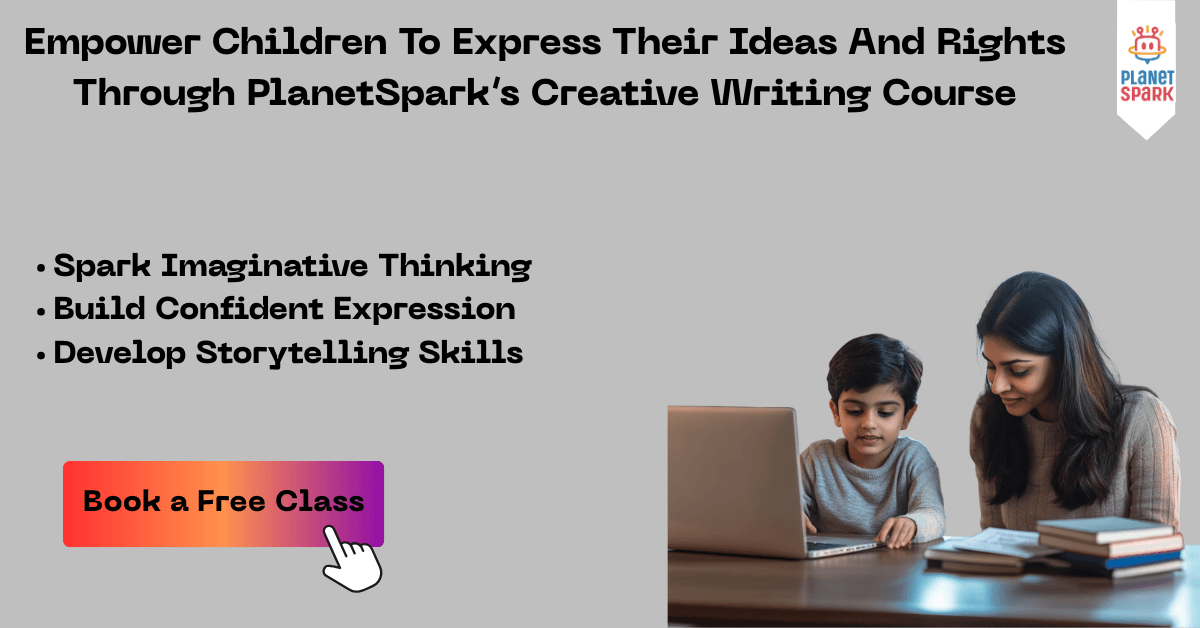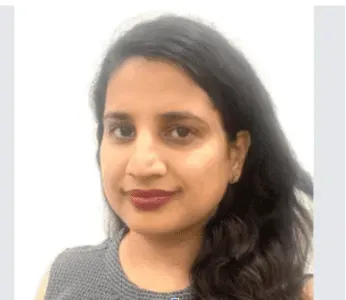Child Rights in India: Laws, Challenges & Solutions

Table of Contents
- Kailash Satyarthi: The Torchbearer of Child Rights in India
- Impactful Contributions to Society
- Global Recognition and the Nobel Peace Prize
- The Legacy of Kailash Satyarthi
- Understanding Child Rights in India
- Legal & Policy Framework for Child Rights
- Scale & Nature of Child Exploitation
- Root Causes of Child Exploitation
- Stakeholder Efforts: Government, NGOs, International Agencie
- Challenges & Gaps
- 6. Recommended Strategies & Solutions
- Role of Education & Youth Voice
- How PlanetSpark is Cultivating Change Through Creative Expre
- Conclusion: Writing the Future, One Story at a Time
- Frequently Asked Questions (FAQs)
Children are the future of our nation, yet millions in India are denied the rights they deserve. From child labour to lack of access to quality education, the challenges are many. Understanding child rights is not just about knowing laws, it's about inspiring action. And what better way to begin than through storytelling and impactful writing?
At PlanetSpark, we believe in empowering young minds with the tools to express, advocate, and influence change. Our Creative Writing Courses are designed to build core writing skills, from structuring persuasive essays to narrating emotional stories. With 1:1 live classes, AI-enabled tools like SparkX, and interactive learning clubs, PlanetSpark makes writing exciting and transformational. Whether it’s preparing a speech on social issues or writing a compelling story, your child learns to make their voice count.
Now, let us explore one of the most important topics of our time: Child Rights in India. And the incredible story of a man who dedicated his life to protecting them.
Kailash Satyarthi: The Torchbearer of Child Rights in India
Early Life and Compassionate Roots
Born as Kailash Sharma on January 11, 1954, in Vidisha, Madhya Pradesh, Kailash Satyarthi displayed a deep concern for others even as a child. He formed a football club to raise funds to help underprivileged children attend school.
He also spearheaded efforts to create a textbook bank to make education accessible to children who couldn't afford study materials. His compassion grew into a lifelong mission.
Education and The Shift Toward Activism
In 1974, Satyarthi graduated with a degree in electrical engineering from Samrat Ashok Technological Institute in Vidisha. Despite a promising career path in engineering, his heart was elsewhere.
By 1977, he moved to New Delhi, where he founded a magazine titled "Sangharsh Jaari Rahega" (The Struggle Shall Continue). It documented the lives of India’s marginalized communities, particularly the exploitation of children.
Founding Bachpan Bachao Andolan (BBA)
In 1980, driven by the growing plight of India’s child labourers, he founded the Bachpan Bachao Andolan (Save Childhood Movement). The goal was clear:
Rescue, rehabilitate, and educate children trapped in bonded labour and slavery.
Satyarthi and BBA volunteers conducted multiple rescue operations across factories, homes, and workshops. They rescued thousands of children who were forced to work for meagre wages or as repayment for their parents' debts.
Give your child the tools to write boldly about justice, equality, and rights. Join PlanetSpark’s Creative Writing Program and book a free session now.
Impactful Contributions to Society
Creation of Rehabilitation Ashrams
In 1990, Satyarthi established ashrams across India to house and educate freed children. These spaces provided not only shelter but also psychological support and structured education to help children reintegrate into society.
Launch of Bal Mitra Gram (Child-Friendly Villages)
His advocacy led the Indian government to implement the Bal Mitra Gram program, transforming over 350 villages into child-labour-free communities. The program focuses on child rights awareness, education, and the active participation of children in community decisions.
Global Recognition and the Nobel Peace Prize
Kailash Satyarthi's efforts were recognised globally when he was awarded the Nobel Peace Prize in 2014, alongside Malala Yousafzai, a Pakistani education activist.
"For their struggle against the suppression of children and young people and for the right of all children to education."
This award validated the decades of selfless work that brought international focus to the cruel exploitation of children.

The Legacy of Kailash Satyarthi
Kailash Satyarthi’s legacy lies in the lives he changed:
- Over 100,000 children have been rescued and rehabilitated
- Sparked global awareness about child trafficking and forced labour
- Advocated at the United Nations and the ILO for stronger child rights enforcement
- Founded the Global March Against Child Labour, the world’s largest civil society network for child rights
Understanding Child Rights in India
Child rights refer to the fundamental entitlements granted to children globally under the United Nations Convention on the Rights of the Child (UNCRC). These include the right to:
- Survival and development
- Protection from exploitation and abuse
- Participation in matters affecting the child
- Access to education and health care
Despite legal frameworks like the Right to Education Act (2009) and the Child Labour (Prohibition and Regulation) Amendment Act (2016), the implementation remains inconsistent across India. Social, economic, and cultural factors often force children into labour, depriving them of their rights.
Empower the next generation of child rights advocates through storytelling. Sign up for PlanetSpark’s Creative Writing Course with a free session included.
Legal & Policy Framework for Child Rights
1.1 Major Laws
Child Labour (Prohibition & Regulation) Act, 1986 (amended 2016) prohibits child labour in hazardous industries and restricts it in family enterprises. Enforcement is patchy.
Bonded Labour System (Abolition) Act, 1976, criminalizes bonded labour, which often includes forced child labour.
Juvenile Justice (Care & Protection of Children) Act, 2015 treats the employment of children in hazardous conditions as a criminal offense.
The Commission for Protection of Child Rights Act, 2005, created the NCPCR and State Commissions to monitor child rights and set up Children’s Courts for speedy trials.
1.2 Schemes & Digital Tools
National Child Labour Project (NCLP) runs Special Training Centres (STCs) across 312+ districts, offering bridge education, vocational training, stipends, and mid-day meals. Over 1.2 million children rescued since inception.
PENCIL Portal (Platform for Effective Enforcement for No Child Labour) connects central, state, te, and district bodies; it enables complaint registration and tracking, though utilization and onboarding remain incomplete.
Scale & Nature of Child Exploitation
2.1 Prevalence & Sectors
India has about 10.1 million child labourers. Globally, 138 million children remain in child labour, with over 54 million in hazardous occupations.
New hotspots include spas, massage parlours, orchestra troupes, and placement agencies, often involving sexual exploitation or forced begging.
2.2 Rescue and Recidivism Trends
In 2024–25, 53,651 children were rescued across 24 states; 44,902 from labour, nearly 3,000 from sexual exploitation, and 1,500 from forced begging. 8,749 missing children were also traced.
States most active: Telangana (11,063 rescues), Bihar (3,974), Rajasthan (3,847), UP (3,804), and Delhi (2,588).
Legal action: 38,388 FIRs filed, 5,809 arrests across the country, with 85 % tied to child labour.
High recidivism: e.g., 70 % of children recently rescued in Krishna/NTR districts of Andhra Pradesh returned to work due to poor follow-up.
2.3 Emerging Drivers
Trafficking crisis post-disasters: In Bihar flood‑hit regions such as Sitamarhi and Madhubani, traffickers abused vulnerable families; children were forced into work or sexual exploitation, especially in orchestras.
In Delhi, a 51 % surge in rescues in 2025 indicates rising trafficking from poorer states. Many children end up in harsh labour conditions with minimal pay.
Root Causes of Child Exploitation
3.1 Poverty & Economic Vulnerability
Extreme poverty forces families to depend on children’s meagre income for education. This becomes an intergenerational trap.
3.2 Education Gaps & Awareness
Lack of access to quality schooling and unawareness of legal protections perpetuate child labour.
3.3 Weak Enforcement & Corruption
Enforcement agencies (e.g., labour inspectors) are under‑resourced. Inspections are rare, penalties are weak, and corruption creates loopholes.
3.4 Informal & Hidden Sectors
Child labour thrives in unregulated sectors—agriculture, domestic work, and small workshops—where children remain invisible to authorities.
Complex global supply chains—for bricks, garments, stone, textiles—often conceal child labour beyond brand audits.
3.5 Inadequate Rehabilitation & Follow‑Up
Many rescued children lack sustained rehabilitation support. Psychological trauma and lack of educational reintegration lead many to return to labour.
Kailash Satyarthi fought for every child’s right to be heard. Help your child find their voice with PlanetSpark. Start with a free creative writing class today.
Stakeholder Efforts: Government, NGOs, International Agencies
4.1 Government Actions
Expansion of NCLP, midday meals programs, Sarva Shiksha Abhiyan, and ICDS to reduce dropout rates.
Bihar’s Operation Naya Savera (July–Aug 2025) rescued 624 minors, arrested 144 traffickers via coordinated police‑NGO effort.
4.2 Civil Society & NGOs
Bachpan Bachao Andolan (BBA): Founded in 1980, it saved nearly 100,000 children, pioneered the Bal Mitra Gram model for child‑friendly villages. Shelters like Mukti Ashram and Bal Ashram provide care, education, and legal support.
Aarambh India: Focuses on child sexual abuse prevention and reporting, and supported India’s first child sexual abuse imagery hotline.
Childline 1098: Toll‑free helpline handling ~1M calls monthly, rescuing ~400,000 children per year. Operates under the Juvenile Justice law to involve Child Welfare Committees.
4.3 International Support
UNICEF India strengthens child protection systems, promotes family‑based care, enforces POCSO and juvenile justice legislation, and integrates mental health and social protection.
India participates in ILO Conventions 138 & 182, and SDG 8.7 target to eliminate child labour and exploitation.
Challenges & Gaps
5.1 Enforcement Weakness
High rescue counts but low arrests/prosecutions in states like UP & MP show enforcement gaps.
Corruption, understaffed inspections, and a lack of coordinated follow-up limit effectiveness.
5.2 Rehabilitation & Education
Rescued children often lack long‑term support, counseling, schooling, or livelihood training, leading to recidivism.
5.3 Awareness & Community Buy‑In
In many rural or marginalized areas, child labour is normalized or seen as necessary. Awareness initiatives lag.
5.4 Invisible Exploitation
Supply chains and informal sectors hide child labour, making detection difficult even for global brands or auditors.

6. Recommended Strategies & Solutions
6.1 Strengthen Legal Enforcement
Increase staffing and resources for labour departments; upgrade penalties and ensure prosecution.
Establish a National Mission to End Child Labour with funding, coordinated enforcement, and district‑level task forces.
6.2 Empower Communities & Raise Awareness
Conduct local campaigns, involve community leaders and parents, and highlight the long-term cost of child labour versus education.
6.3 Ensure Effective Rehabilitation
Support comprehensive reintegration: schooling, counselling, vocational skills, financial aid, and monitoring through schemes like NCLP.
6.4 Leverage Technology
Enhance PENCIL portal use; integrate with Mission Vatsalya and Childline; use data dashboards for real-time tracking.
6.5 Regulate Supply Chains
Mandate transparency in supply chains; enforce compliance in industries like textiles, stone, leather, and agriculture; and involve corporate responsibility.
6.6 Foster International Collaboration
Collaborate under ILO standards, share best practices with other nations, and secure funding for NGOs and state programs.
Inspire your child to become a voice for change, just like Kailash Satyarthi. Enroll them in PlanetSpark’s Creative Writing Course and unlock a free trial class today.
Role of Education & Youth Voice
Educating children and youth, especially through writing and expression, empowers them to speak up and advocate for their rights. Programs like PlanetSpark’s Creative Writing Courses help students articulate social issues, develop critical thinking, and become changemakers.
How PlanetSpark is Cultivating Change Through Creative Expression
At PlanetSpark, we nurture not just writing but writing with purpose. Here's how:
1:1 Personal Trainers for Every Child
Every learner is paired with a certified communication expert who:
- Understands individual learning styles
- Offers live, personalized feedback
- Builds fluency, storytelling, public speaking, and writing skills
Personalised Curriculum and Learning Roadmap
We assess every child and:
- Identify grammar and writing gaps
- Design tailored learning paths
- Regularly update content to match their pace and progress
SparkX: AI-Powered Video Feedback
Our AI tool evaluates:
- Voice modulation, clarity, and posture
- Grammar and structure of speeches
- Confidence and delivery
AI-Led Practice for Speeches and Storytelling
Kids engage in AI-led sessions that:
- Simulate real-life speaking scenarios
- Offer instant feedback on delivery and structure
Spark Diary for Writing Consistency
Children use this feature to:
- Maintain a daily writing journal
- Work on structured prompts
- Build writing confidence
Gamified Learning Modules
Interactive games like:
- Grammar Guru Challenge
- Spell Knockout
- Antonyms Quiz
- Word Wisdom
Make learning fun and engaging.
Parent-Teacher Meetings (PTMs)
Regular PTMs:
- Share progress reports
- Discuss development areas
- Align learning strategies with parents
Detailed Progress Reports
Comprehensive evaluations cover:
- Content quality, voice, and grammar
- Organisation, confidence, and critical thinking
Learning Clubs & Communities
Creative writing goes beyond the classroom in our clubs:
- Debate Club
- Story Writing Guild
- Podcasting & Comedy Club
- Speech and Poetry Circles
Sparkline: A Safe Content Sharing Platform
- Share creative content
- Get peer feedback
- Build digital expression skills
Contests, Showcases, and Recognition
Children participate in:
- Storytelling competitions
- Writing and speech challenges
- Open mic and talent showcases
SparkBee & SparkShop
- SparkBee: Engaging daily quizzes to improve grammar and vocabulary
- SparkShop: Access to eBooks covering writing, vocabulary, and grammar skills
Conclusion: Writing the Future, One Story at a Time
Kailash Satyarthi has shown the world the power of one man’s conviction. His life reminds us that change begins when someone decides to act. Children across India are now safer and more empowered thanks to his relentless mission.
As we educate future generations, it is essential to instill awareness and empathy. Platforms like PlanetSpark play a key role in shaping young changemakers. Through our Creative Writing Courses, we teach children not just to write, but to express, question, and transform.
Let your child become the voice of change. Enroll them in PlanetSpark’s Creative Writing Program today.
Help your child learn the art of advocacy through writing. Enroll in PlanetSpark’s Creative Writing Classes and claim your free trial class today.
Frequently Asked Questions (FAQs)
1. What are child rights in India?
Child rights refer to the basic rights every child is entitled to, including the right to survival, education, protection, and participation, as defined by the UNCRC and Indian legal frameworks.
2. Who is Kailash Satyarthi?
Kailash Satyarthi is a Nobel Peace Prize-winning child rights activist from India who founded Bachpan Bachao Andolan and has rescued over 100,000 children from child labour and exploitation.
3. What is the Bachpan Bachao Andolan?
Founded in 1980 by Kailash Satyarthi, BBA is an NGO that works to eliminate child labour and ensure the right to education for all children in India.
4. What is the Bal Mitra Gram program?
Bal Mitra Gram (Child-Friendly Village) is an initiative launched by the Indian government to create villages free of child labour, inspired by the work of Kailash Satyarthi.
5. How can children learn about social issues through writing?
Writing enables children to explore topics like child rights, express opinions, and advocate for change. PlanetSpark’s Creative Writing Courses encourage such impactful learning.
6. What makes PlanetSpark's Creative Writing Course unique?
PlanetSpark offers 1:1 live classes, personalised learning paths, AI-powered tools, writing journals, and regular progress tracking to ensure comprehensive writing development.
7. How do PlanetSpark's clubs and contests help children?
These platforms give children real-world exposure, creative collaboration, and the confidence to express ideas in front of peers, helping them grow as well-rounded communicators.
Personalized Communication Report
Record a video to get a AI generated personalized communication report for your child

Hi There, want to try these
tips for your child with
LIVE with our expert coach?
Let's check your child's
English fluency
